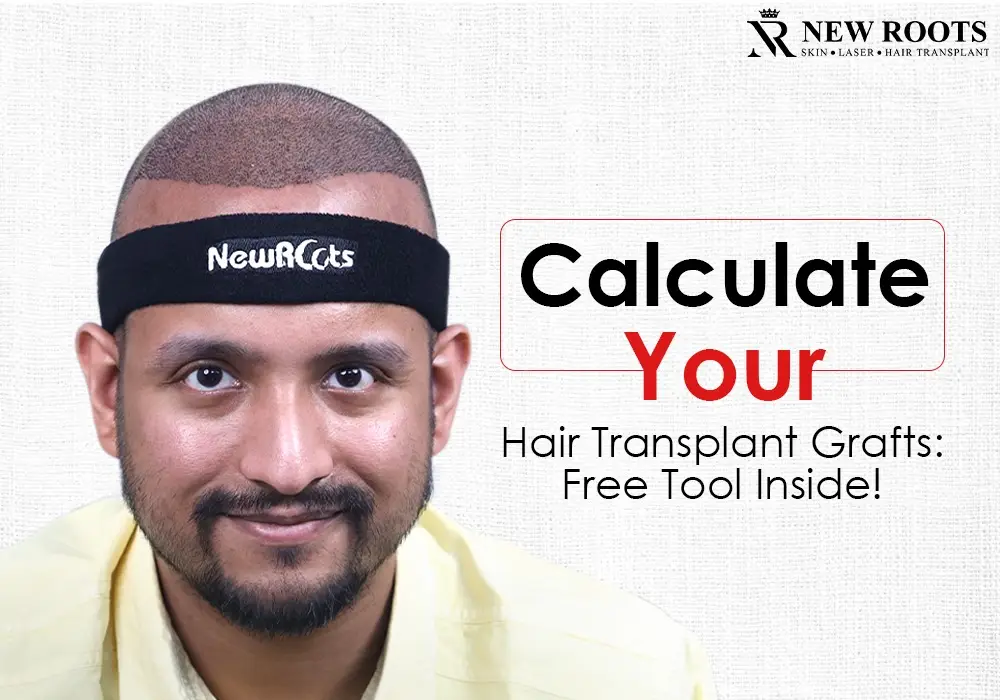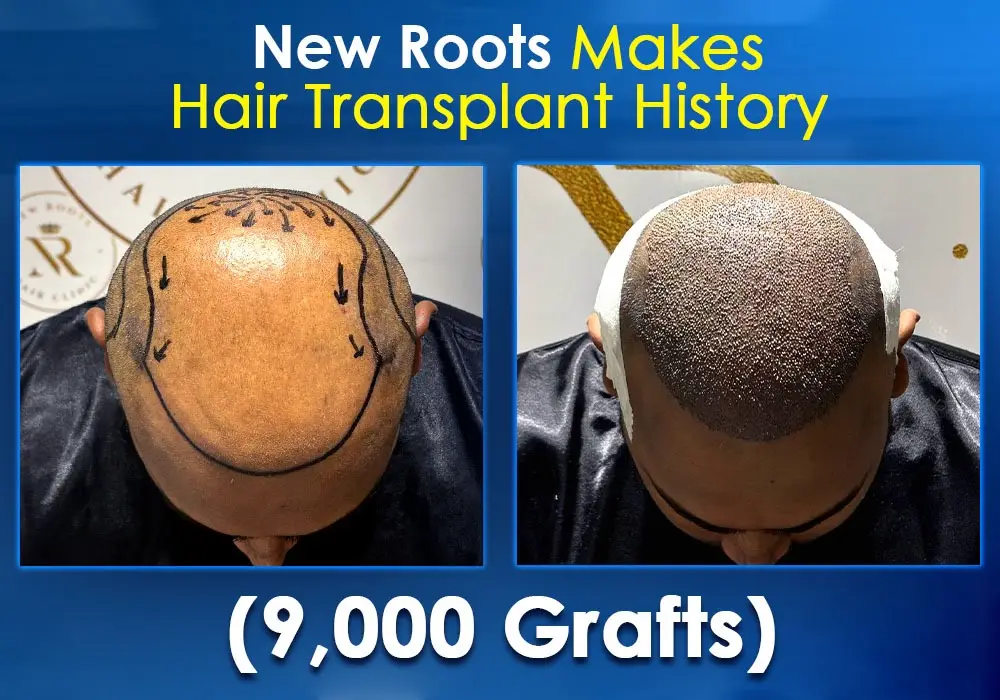Calculate Your Hair Transplant Grafts: Free Tool Inside!
When it comes to the specifics, anyone contemplating getting a hair transplant may feel quite excited yet anxious at the same time. One of the crucial stages a person has to go through while choosing the essence of the operation is calculating the number of grafts needed to obtain the desired result.
More importantly, the individual must know how to care for the new hair to ensure smooth healing and the best results. This article will also explain how the number of grafts will be determined and cover tips for post-hair transplant recovery.
Table of Contents:
- Understanding the Importance of Graft Count
- key factors that can influence hair transplant procedure in How to calculate the number of grafts
- 10 points on How to calculate the number of grafts for a hair transplant procedure
- Understanding the importance of calculating the number of grafts for a hair transplant procedure
- The Role of Technology in Graft Calculation
- Frequently Asked Questions on How to calculate the number of grafts
Understanding the Importance of Graft Count:
The primary step that can mostly dictate the likelihood of success in hair transplants is the main focus on How to calculate the number of grafts. In predicting the possibility of hair transplant surgery results, the graft count, the actual hair follicular units, or individual hairs to be transplanted play the most crucial role.
The number of grafts extracted decides the slit-making procedure. The more grafts, the more the bald area will likely be covered. The expected number of grafts harvested gives an idea to the surgeon to decide the spacing between two slits, which determines your hair density.
The mathematical approach to determining the number of grafts needed is critical because it would decide if the result is reasonable and proportional, would look good, and would only experience a few problems during the healing period.
Key factors that can influence hair transplant procedure in How to calculate the number of grafts
1. Donor Hair Density:
One of the most critical factors is hair density in the donor area, described in the number of follicular units per square centimeter.
2. Recipient Area Size:
Depending on the staff’s assessment of how large an area needs to be covered or how much balding or thinning must be hidden, many grafts will be required.
3. Desired Hair Density in Recipient Area:
The expectancy of the grafts /sq. cm in the recipient area will influence the total amount of grafts.
4. Hair Characteristics:
Other variables, such as the number of hairs per scalar area and the quality of the donor's hair, may be used to alter the graft calculation.
5. Previous Hair Transplant Procedures:
If the patient has had earlier hair transplants, there should be views of other hairs in the donor area.
6. Donor Area Limitations:
The limitation is the surgeon's ability to harvest grafts from the donor site while preserving the donor sources.
7. Graft Survival Rate:
The percentage of grafts expected to take or grow in the recipient area, estimated before the transplant surgery.
8. Desired Coverage and Distribution:
He explained to me the positive number and arrangement of grafts that have to be placed to achieve a particular aesthetic effect.
10 points on How to calculate the number of grafts for a hair transplant procedure:
Each graft is counted and transferred to other staff for inspection and cleaning during extraction. He also counts and makes sure the graft is viable. After cleaning, it is transferred to the nutritious media for storage, and its appropriate temperature is maintained until implanted. These grafts are stored in 500 numbers in each petri dish and chamber. These are not only counted but also stored chronologically.
1. Determine the total hair loss or balding area:
This is usually indicated in square centimeters (cm²) or square inches (in²).
2. Estimate the hair density in the donor area:
This is most often measured in the number of hair follicular units per square centimeter (FU/sq cm).
3. Assess the individual hair follicular unit characteristics:
Consider the hair per follicular unit—it can be 1, 2, 3, and even 4 hair and even more.

4. Factor in the desired hair density in the recipient area:
This illustrates the expected hairs per square centimeter by the surgeon’s expectation.
5. Determine the percentage of grafts that will be used for the procedure:
Not all the harvested grafts may be viable for transplantation; therefore, what is usually given as a percentage of the total harvested grafts is ejected.
6. Consider the desired coverage area:
In general, the size of the area required to accommodate the grafts will define the number of grafts to be applied.
7. Adjust for previous procedures:
In this case, the number of available donor hair should be considered, although this hair may still be extracted after prior hair transplant operations.
8. Incorporate a safety margin:
People tend to forecast more than required so that those that may be spoiled or lost during the process can be replaced.
9. Consult with an experienced hair transplant surgeon:
This shows high willingness since they can set goals according to the patient's details, so it will be hard for the patient to escape the care.
10. Use calculators or formulas:
Currently, online tools and graft coefficient formulas allow calculating the necessary number of grafts based on the abovementioned factors.
Understanding the importance of calculating the number of grafts for a hair transplant procedure:
Here are some critical hair transplant procedures. How to calculate the number of grafts for a hair transplant :
1. Achieving Desired Outcome:
This is why it is very vital to estimate the number of grafts required to ass the optimum result in hair transplant surgery.
2. Optimizing Donor Utilization:
Estimate the hair throughput that will be possible during the surgery and search for areas of the body where hair is more thickly located to preserve the valuable donor hairs.
3. Minimizing Wastage:
Effective graft issues help eliminate over-resection and under-resection, including wasting the grafts and improper utilization of the donor's hair.
4. Preventing Complications:
This is important so as not to make mistakes, such as extracting too many hair follicles, which can harm the donor area or produce scar tissue.
5. Customized Treatment Plan:
To this end, it is applied to define the graft computation that varies depending on the customer’s hair attributes, density, and transplantation goals.
6. Managing Patient Expectations:
Mas introduction may help control the patient's expectations regarding the potential graft appearance and the number of procedures the patient will undergo to achieve the desired shape.
7. Cost Estimation:
The result will depend on the number of grafts, as this factor is directly linked with the price of the surgery. Therefore, patients may evaluate potential costs.
8. Long-term Sustainability:
The result will depend on the number of grafts, as this factor is directly linked with the price of the surgery. Therefore, patientaHence, the number of grafts needed is the one that fits the contour of the recipient area and gives a complete and long-lasting result without necessarily sullying the aesthetics of the infused hair and in exclusion of future surgery. s may evaluate potential costs.
The Role of Technology in Graft Calculation:
Resulting from this research study, an understanding of the role of technology in hair transplant is as follows:
The improvement in technology has dramatically helped in obtaining greater precision of graft calculation in hair transplant surgery. With the help of specialized software and imaging tools, hair restoration specialists can study the donor and recipient area in detail, track the possible results to be achieved, and adjust the latter to the correct number of grafted hairs.
Hair transplant software commonly involves the following features:
An example of these technologies is digital imaging, which enables the physician to obtain clear images of the scalp and hair. Such pictures can then be used to evaluate the hair density frequency distribution and, more so, their growth patterns to determine the precise, accurate graft count.
Also, 3D modeling and simulation, used by specialists to model the treatment outcomes, will provide the patients with a substantial understanding of the future treatment and its potential outcomes.
The issue of digital imaging in hair transplant:
In addition, some hair restoration clinics also use a database of cases with unique algorithms to evaluate the existing experience and outcomes. This information can be used to optimize further before data on how to calculate the number of grafts is used.
This ensures that the treatment plan set out for the particular patient will consider the best characteristics for the transplant and will optimize the most optimal time for the transplant.
Databases of hair transplant and decision-making algorithms:
Achieving the Optimal Graft Count
Thus, the number of grafts in a hair transplant becomes critical in achieving the best aesthetic result and minimizing the risks of harm to the donor area.
The balance between graft count and donor area is:
Through the methods already mentioned, hair restoration specialists aim to have the proper density and coverage without extracting too much or too little hair from the donor area.
Overharvesting can reduce the supply of the harvested body part, leading to possible permanent scarring of the region from which it is harvested; underharvesting, on the other hand, will lead to a clinically poor aesthetic outcome for the recipient.
Impact of over-extraction and under-extraction in biomass resources:
As indicated above, two extreme scenarios in exploiting biomass resources may lead to the following complications.
Hoping that the graft count is well determined and due to the incorporation of different technological experiences, hair restoration specialists are in a position to develop the best mechanism for addressing the patient’s needs.
It also has the advantages of guaranteeing the success of the operation, the stability, and the natural appearance of the hairline in the medium-long term.
Frequently Asked Questions on How to calculate the number of grafts:
Generally, thinning from the front to the crown requires about 3500 grafts (equivalent to 7000 hairs), thinning in the front third requires about 2500 grafts (5000 hairs), and bald individuals may require 6000-7000 grafts done over two procedures (12000 – 14000 hairs) for adequate coverage.
There are three critical criteria used to determine how many grafts you’ll need:
- The extent of your hair loss.
- The rate of your continuing hair loss.
- Potential future hair transplants.
People considering hair transplants often wonder how many hairs per graft there are. If you’re looking at having a transplant where 4000 grafts will be taken from your donor site, you’ll be pleased to hear that this should yield around 7200 – 8800 hairs.





